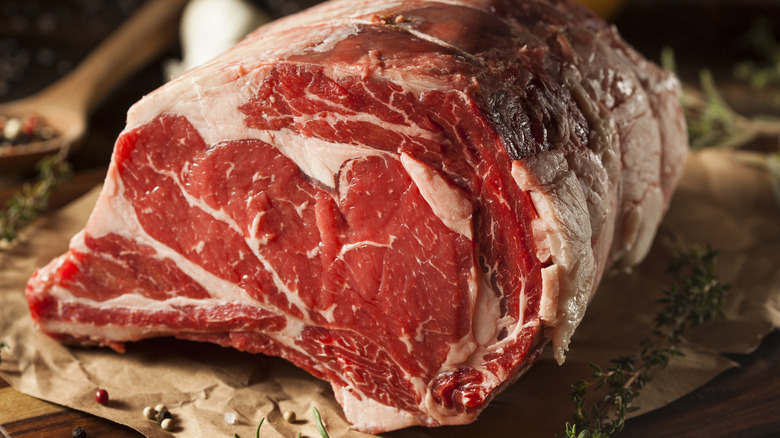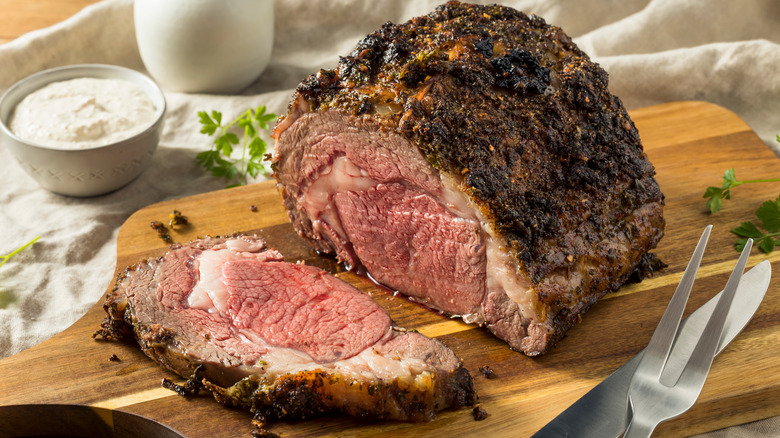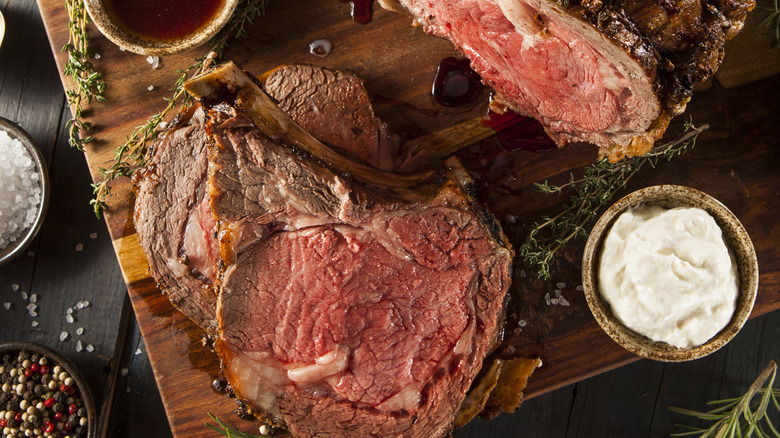The First Thing To Look For When Buying Prime Rib
Some main courses are just a cut above the rest. They're the ones that birthdays and special celebrations are made of. Prime rib is definitely one of those meals, and although it has the potential to be the centerpiece of an incredible dinner, it's also easy to get wrong. There are a number of mistakes everyone makes when cooking prime rib, and one of the biggest blunders comes before you even start the cooking process. Selecting a less-than-stellar cut of meat will sabotage your attempt from the beginning, but fortunately, there are some easy-to-remember guidelines that you can keep in mind — starting with the size of the prime rib.
If you're cooking for yourself or just two people — or if you're considering cooking several individual prime rib roasts — it might be tempting to get a smaller piece (or pieces). However, that is a huge mistake; you should be looking for a piece with at least three ribs. That is arguably as important as other considerations, like the amount of marbling.
Prime rib can be difficult to cook right because you want a flavorful crust on the outside while keeping the inside pink and juicy. If you choose a piece of meat that's too small, that will be next to impossible to achieve. Opt for a larger piece, and don't worry — there are plenty of options for leftovers — if there are any leftovers at all.
Here's what to look for when choosing a prime rib
Since prime rib can be an expensive and difficult-to-prepare protein, we wholeheartedly recommend speaking to the butcher at your meat counter when it comes time to select your prime rib roast. A good butcher will not only be able to trim a prime rib roast in a way that will leave you with the right amount of fat, but they'll appreciate that you've done your homework ahead of time and know what you're looking for.
That starts with a roast that has at least three rib bones. As a general rule, you only want the inside of a prime rib to hit around 130 degrees Fahrenheit, which means that a small rib roast can quickly get overcooked while you're waiting for the outside crust to form.
There are a few other things you should be looking for, whether opting for three ribs or going even larger. Look for meat that has even, regular marbling throughout; that's key to maintaining the tender, juicy texture that prime rib is renowned for. The fat should be bright white, and if you ask for ribs that come from near the loin of the cow, that's going to generally be more tender. Why? It isn't worked as hard during the cow's life.
There are plenty of options for leftover prime rib
A general rule is that you can plan on each rib yielding enough meat for two people, so that three-rib roast might seem like it's too much. But you should still get it, as there are plenty of meal options, and yes, you can freeze cooked leftover prime rib. Leave it whole, wrap it in plastic wrap, and freeze. It'll keep for around six months.
If you plan to use your leftovers within one week, there's no need to freeze them. If you cook for someone who isn't a fan of prime rib's rare doneness, they may appreciate leftovers cooked into a beef stew filled with vegetables and potatoes or a stir fry served with peppers or broccoli. Slow-cooking, stews, and sauces all work well with leftover prime rib, and turning it into a beef stroganoff or using it with pasta is sure to become a special-occasion favorite.
Leftover prime rib also makes for a delicious steak and eggs or hash breakfast. It shines in sandwiches, too. Use prime rib in Philly cheesesteaks and French dips, or serve up a Southern version by whipping up a spicy pimento cheese and using that as your sandwich spread. You can also swap out the standard ground beef topping for some incredible leftover prime rib nachos, and you might just find yourself getting a larger-than-needed prime rib just for leftovers that will last a week.


